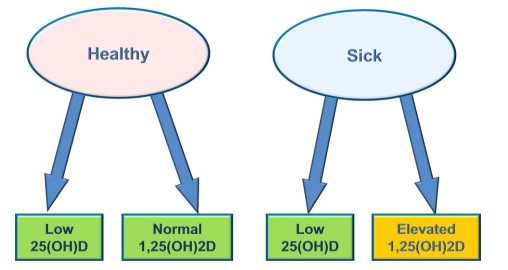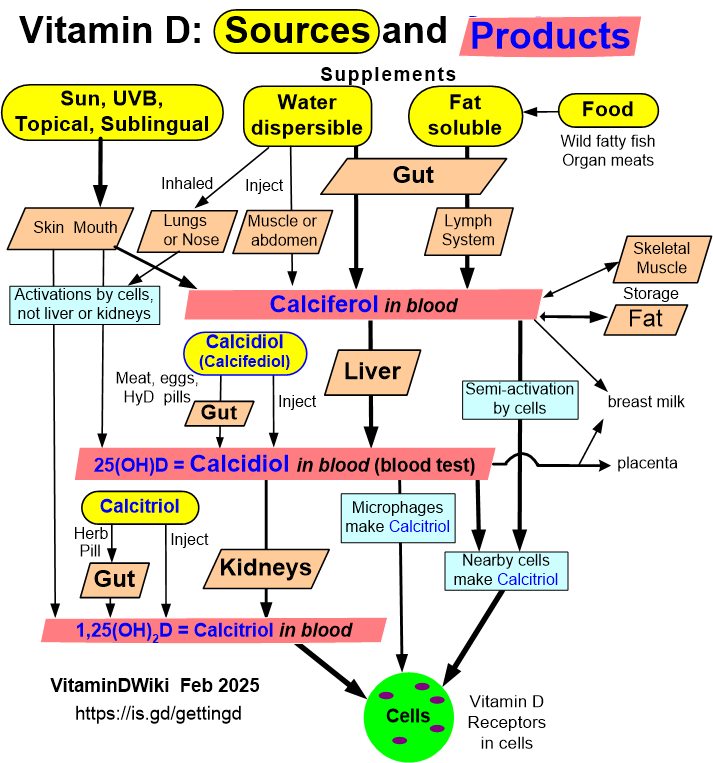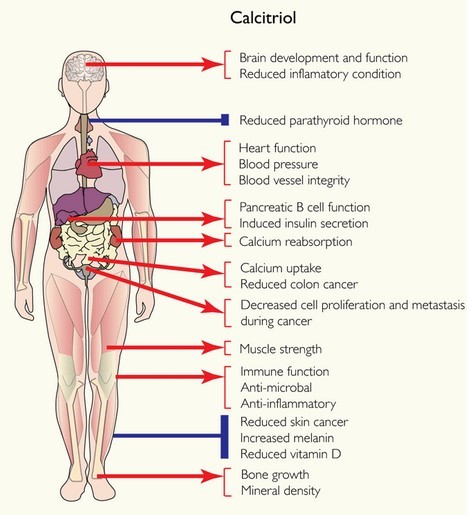Active Vitamin D (Calcitriol) reference ranges, why too high is a problem
Two items by Mangin on the page
1,25(OH)2D (Calcitriol) Reference Ranges
Apr 8, 2015 Linked-in Meg Mangin, RN
Measurement of serum 1,25-dihydroxyvitamin D [1,25(OH)2D] is done by radioimmunoassay (RIA). 1,25(OH)2D lab reference ranges are determined by statistical analysis of the people who have had 1,25(OH)2D measured. The "normal” range is where 95% of the people measured fall.
However, the current standard advises measurement of 1,25(OH)2D only in patients with, or suspected of, serious medical conditions such as
hypercalcemia,
renal failure,
sarcoidosis,
lymphoma,
abnormalities of 1-alphahydroxylase,
hyphophosphatic rickets,
primary hyperparathyroidism,
hypoparathyroidism,
pseudohypoparathyroidism,
renal osteodystrophy,
vitamin D-resistant rickets or
vitamin D receptor defects.
This population cannot be considered normal. Thus, lab ranges do not provide an accurate assessment of a normal level of 1,25(OH)2D.
Statistics on 1,25(OH)2D in a normal population are very limited. The best data comes from a 1999 cross-sectional study of the influence of smoking on serum parathyroid hormone (PTH), serum vitamin D metabolites, serum ionized calcium, serum phosphate, and biochemical markers of bone turnover. In this study, serum 1,25(OH)2D was measured, via radioimmunoassay, in a cohort of 510 healthy Danish women aged 45 to 58 years. The average 1,25(OH)2D level of the non-smokers in this group was 29.0 pg/mL (plus or minus 9.5 pg/mL) for a range of 19.5 - 38.5 pg/mL in this healthy population. [1]
Furthermore, when measured coincidentally, the significance of elevated 1,25(OH)2D may be overlooked. For example, a 2011 study of the effect of vitamin D and calcium supplementation on patients with multiple sclerosis, revealed elevated 1,25(OH)2D at baseline and one year later (61 pg/mL ± 22.6 pg/mL and 70.7 pg/mL ± 18 pg/mL respectively). [2] All of these 1,25(OH)2D levels were considered normal. Calcium, phosphorus and parathyroid hormone were not measured in those whose 1,25(OH)2D exceeded the normal range.
The Merck Manual of Diagnosis and Therapy (15 Oct 2006 online) listed the range of serum 1,25(OH)2D in healthy persons as 20-45 pg/mL.
The 2013 edition lists the normal range as 25–65 pg/mL.
The Mayo Clinic lists 18 - 78 pg/mL as the normal range.
It's disappointing to note that on March 16, 2015 Labcorp raised their normal range of 1,25(OH)2D from 10 - 75 pg/mL to 19.9 - 79.3 pg/mL.
As the incidence of chronic illness increases and serum 1,25(OH)2D levels rise, authorities simply increase the range of 1,25(OH)2D that is considered normal. This signifies a failure to recognize elevated 1,25(OH)2D as a sign of dysregulated vitamin D metabolism and a marker of a chronic inflammatory disease process . Studies need to be done to determine the serum level of 1,25(OH))2D in healthy populations. Using reference ranges that truly represent normal will promote accurate diagnosis of vitamin D endocrine dysfunction.
References
1. Brot C, Jorgensen NR, Sorensen OH The influence of smoking on vitamin D status and calcium metabolism. Eur J Clin Nutr. 1999;53:920-6.
2. Kimball S, Vieth R, Dosch HM, et al. Cholecalciferol plus calcium suppresses abnormal PBMC reactivity in patients with multiple sclerosis. J Clin Endocrinol Metab. Sep 2011(96(9)):2826-34.
Inflammation and vitamin D: the infection connection. - Oct 2014
Inflamm Res. 2014 Oct;63(10):803-19. doi: 10.1007/s00011-014-0755-z
Mangin M1, Sinha R, Fincher K.
1Chronic Illness Recovery, Fort Worth, Texas, USA, [email protected].
INTRODUCTION:
Inflammation is believed to be a contributing factor to many chronic diseases. The influence of vitamin D deficiency on inflammation is being explored but studies have not demonstrated a causative effect.
METHODS:
Low serum 25(OH)D is also found in healthy persons exposed to adequate sunlight. Despite increased vitamin D supplementation inflammatory diseases are increasing. The current method of determining vitamin D status may be at fault. The level of 25(OH)D does not always reflect the level of 1,25(OH)2D. Assessment of both metabolites often reveals elevated 1,25(OH)2D, indicating abnormal vitamin D endocrine function.
FINDINGS:
This article reviews vitamin D's influence on the immune system, examines the myths regarding vitamin D photosynthesis, discusses ways to accurately assess vitamin D status, describes the risks of supplementation, explains the effect of persistent infection on vitamin D metabolism and presents a novel immunotherapy which provides evidence of an infection connection to inflammation.
CONCLUSION:
Some authorities now believe that low 25(OH)D is a consequence of chronic inflammation rather than the cause. Research points to a bacterial etiology pathogenesis for an inflammatory disease process which results in high 1,25(OH)2D and low 25(OH)D. Immunotherapy, directed at eradicating persistent intracellular pathogens, corrects dysregulated vitamin D metabolism and resolves inflammatory symptoms.


📄 Download the PDF from Vitamin D Life
See also Vitamin D Life
Calcitriol category listing has items along with related searches
Calcitriol, not inactive vitamin D, associated with pain in seniors – Aug 2014
Blacks have lower vitamin D levels, but OK active vitamin D levels (VDBP) - Feb 2015
Not as much active vitamin D if poor kidney function and low vitamin D – March 2015
Active vitamin D associated with Metabolic Syndrome and LDL in colon cancer patients– March 2015
The TOP articles in Inflammation and Vitamin D are listed here:
{category}
- Vitamin D3 becomes Calcidiol which becomes Calcitriol has the following two items

Calcitriol benefits to the body
VITAMIN D: A NATURAL WONDER DRUG WE’RE ALL AVOIDING? National Institue for Medical Research 2012

